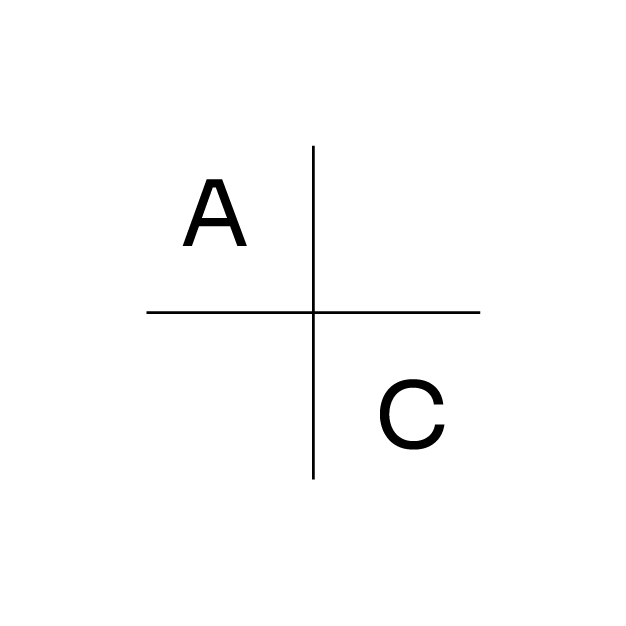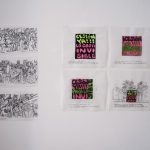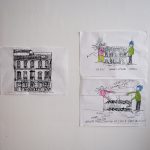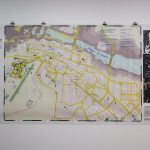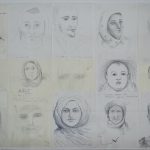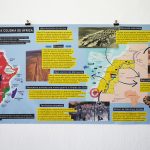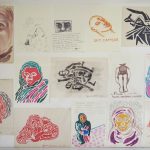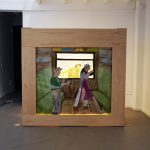Activaciones colectivas
06.05.2023 < 14.07.2023
ACTIVACIONES COLECTIVAS
The exhibition brings together a series of art projects focused on the activation of collective dynamics in search of transformative potential. Each project explores a specific field, a social, political or cultural reality where it seeks a new end; a purpose that transcends the artistic nature of the artwork itself.
Activaciones colectivas investigates how in contemporary artistic practices, the production of art always seeks connection and engagement with the artist. The artist then transforms into an activist, an agent in the service of an idea, who uses their art to provide visibility and the ability to adapt in any situation. Striving to make tangible changes in the social realm we operate in, all the projects here displayed prioritize practicality, communal benefit and natural processes. In this way, each project needs its own ethical and aesthetic consideration.
These art practices, focused on real scale effects, lead the projects to results emancipated from the artists, creating a new alienating materiality. The relationship becomes almost symbiotic, where the artist serves the project as much as the collaborative work nurtures their language and purpose.
Artists /Proyects
LIBIA CASTRO & ÓLAFUR ÓLAFSSON (ES/IS, 1997)
La Rehabilitación de La Casa Invisible – Capítulo 1, 2023
Installation. Video, flag, drawings and mural.
La Casa Invisibile (The Invisible House) is a public cultural and social centre born in March 2007, when a group of citizens, neighbours and creators occupied an abandoned 19th building owned by the town council. From then on, La Invisibile set up a model of communal management of the space, becoming the main point of reference where new institutional processes see to the care and creation of the shared house while opposing the various attempts of eviction by the city council, as they are currently in a situation of precarious cession.
La Rehabilitación de La Casa Invisible – Capítulo 1, is an ongoing transdisciplinary art project that artists Libia Castro & Ólafur Ólafsson, La Invisibile, architect José Manuel López Osorio and curator Gemma Medina Estupiñán began in 2012. It’s a collaborative piece that sees art, architecture, sustainable development, law and activism together in a battle, where different creators of La Casa Invisibile join forces to reclaim the right to the city.
The art project aims to stop the eviction process that the city council of Malaga started in 2022 for the fourth time and reach an agreement with the local authority to transfer the ownership of the site to the cultural centre. Allowing it to continue and finally start the restauration of the building in accordance with the Project presented by La Invisibile and the architect José Manuel López Osorio in 2017.
FEDERICO GUZMÁN (Sevilla, 1964)
Active since the mid 1850s Federico Guzmán (Sevilla, 1964) has always thought of art as a commitment to its environment. His time in New York and Bogotá, at the end of the 90s, led him to reflect on the idea that art can be used as a tool to change society, and that the artist is a medium.
During the last decade Federico Guzmán was often linked to the Sahara due to Tuiza (in Hasania, the language of the Saharawis, collective solidarity work; to participate and build something together), a project by the Museo Reina Sofía at the Palacio de Cristal in Madrid.
The pieces selected for Activaciones Collectiva were made in Western Sahara as part of the ARTIfariti programme. In these works, Federico Guzmán translates the oral experiences passed by the Sahrawi community into drawing and painting.
Retratos de los desaparecidos sharauis, 2010.
Graphite on paper.
The Association of Friendship with the Sahrawi People of Seville and the Association of Relatives of Sahrawi Prisoners and Missing People (AFAPREDESA) started within the ARTifarit 2009 festival an ongoing project in which Sahrawi, Spanish and international artists portray missing people due to Moroccan repression and occupation. At present it is estimated that there are about 500 missing (200 with photographs and 300 of which no graphic document is available). The absence of photographs creates an image drawn by the oral portrait of the person who remembers them to make it a symbol.
Map of the resistance of El Aaiún, 2013.
Mixed technique on paper and cardboard.
A collective work by artists, activists and cartographers, the piece represents a map of El Aaiún, the capital of western Sahara, a former Spanish colony currently occupied by Marocco. The map of the city names, documents and condemns the apartheid state that the Saharawi population faces. The map highlights the main centres of resistance and the most prominent events of violence. The borders of the map of El Aaiún are filled with drawings by Federico Guzmán illustrating the scenes of repression and torture narrated by the people who lived through those events.
ALONSO GIL (Badajoz, 1966)
La tierra grita, 2012. Mixed media on paper.
Mapa del Sahara Occidental, 2013. Pigment print on vinyl.
Lives and works in Seville. Graduated in Fine Arts from the University of Seville, Gil uses the poetic language of images to unravel the political realities embedded in these metaphorical worlds. His practice is characterized by an interest for collaborative projects, such as Cambalache (together with Federico Guzmán and Carolina Caycedo) or Sahara Libre Wear.
In April 2012 Alonso Gil travelled to Aaiún (Western Sahara) together with artist Federico Guzman, doctor Antonio Martinez and art therapist Maria Antonia Hidalgo, in order to collect the testimonies of women, men and children who had suffered arrests, torture and imprisonment because of the occupation of Western Sahara.
Gil created a series of drawings based on the stories of the victims who shared their grief and pain with the artist, becoming an explicit testimony of the atrocities endured by the relatives and witnesses. Human rights violations continue to occur systematically in the occupied territories.
This map shows the Western Sahara conflict, it was made to contextualize the situation of the Sahara as a colonized country, still struggling and awaiting a referendum for self-determination. The map analyses the geopolitical aspects connected/related to/of the plundering of the natural resources, the exile, the invasion, the Wall, armament and the current war between Morocco and the Sahara. Designed by Alonso Gil for the project Humanitarian Aid for the First World (Ayuda humanitaria al primer mundo) that the Cambalache Collective set up in Toronto, Canada in 2015.
It was updated and translated into Spanish and is currently part of the archives of the Museo Nacional Centro de Arte Reina Sofía.
COLECTIVO OJO PÉRTICO
Centro Ocupacional, Centro de Día de la Puebla de Cazalla y Alegría y Piñero.
Panorama en tren, 2021. Performative Installation. Diorama.
Panorama en tren (Train view) is inspired by John Banvard’s 19th century show, pre-cinematography, “Gran panorama movil del Misisipi”. The artwork consists in a rotating structure containing a roll of painted fabric, measuring 1,4m x 60m. The roll is painted on both sides and works as a diorama, whether it is illuminated from the front or the back. The pictures change creating various effects of transition, superimposition or even animation. The canvas is kept rolled up, only a section large 140 x 150 cm is displayed, as it is rotated, different scenes are shown while a sound file composed of narrations, dialogues and musical themes can be heard.
The moving panorama transcends the idea of a picture in motion, it’s a painting technique that offers an audiovisual experience to the viewer based on the physicality of the medium. Not only the viewer contemplates a great pictorial work in continuous change, they are placed in a unique perspective where they have the chance to enter and connect with a creative world, free of conventionalism and stylistic prejudices. A true work of art, made of revealing images, sounds, narratives, lights and shadows, that all together form the imaginary of this group of people with intellectual disabilities, both protagonists and architects of this project.
During the exhibition, Panorama en tren will run with the participation of the occupational centre of Puela de Cazalla.
JULIO JARA (París, 1962)
Sin perfil (al ausente), 2023
Installation. Travel suitcase, clothes and belongings. Sound archive and mural.
A nomadic artist, alien to any school or discipline, Julio Jara dedicates his life to making visible the most vulnerable. He has been living and developing his projects for years in a homeless shelter in Madrid, where he brings together artists, institutions, mediators and citizens. Recently, Julio has moved with his fellow hostelers to the former Monastery of the Immaculate Conception in Loeches, 30 km from the capital, with the idea of transforming the 2,000 square meters of this decaying building, into a living community where artists and people without a home can come together.
Sin perfil (No profile) is part of a workshop organised by Julio Jara with people from various collectives at the San Martín de Porres shelter in Carabanchel, Madrid. The workshop focused on the search for the identity of the person to whom one of the many suitcases, forgotten in the hostel’s wardrobes, belonged. Each of the participants identified certain features in the clothes and belongings contained in the suitcase. The result of the workshop is the creation of a common identity, which is the sum of many different realities and life circumstances situated in extreme and fragile positions. By drawing on this empty profile, a network is constructed with the elements contained in the suitcase, the sounds recorded during the workshop are shared and a mural intervention is created based on the profiles of the participants in the exhibition.
